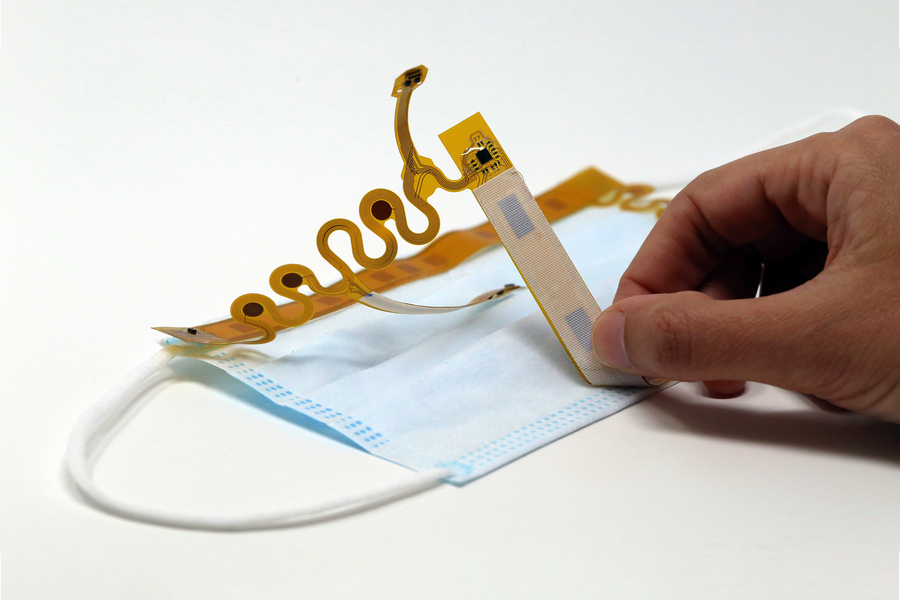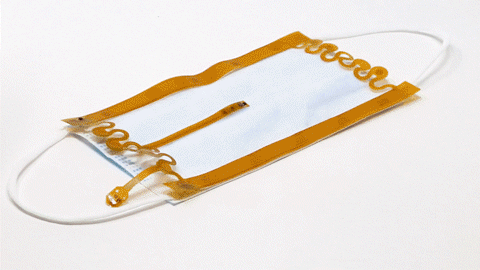创新背景
戴口罩可以帮助防止SARS-CoV-2等病毒的传播,但口罩的有效性取决于它的适应性。
目前,没有简单的方法来测量口罩的贴合度,研究人员通过分析从研究中收集到的数据,意识到在日常生活中使用的口罩不太适合女性参与者,研究人员希望他们的传感器能够帮助人们找到更适合他们的口罩。
创新过程
麻省理工学院开发了一种新型传感器可以更容易地确保良好的贴合度。该传感器用于测量口罩与佩戴者面部之间的物理接触,可应用于任何类型的口罩。使用这种传感器,研究人员分析了外科口罩对男性和女性受试者的贴合度,发现总体而言,这些口罩与女性脸的贴合度远低于与男性脸部的贴合度。
研究人员在Covid-19大流行期间戴口罩变得普遍之前就开始研究这个项目。他们最初的目的是使用嵌入在口罩中的传感器来测量在空气污染水平高的地区戴口罩的有效性。然而,一旦大流行开始,他们意识到这种传感器可以有更广泛的应用。

在大流行期间,有多种不同种类的口罩可用,研究人员认为这种传感器可能有助于帮助个人找到最适合他们的口罩。目前,测量口罩贴合度的唯一方法是使用称为口罩适合性测试仪的机器,该机器通过比较口罩内外的空气颗粒浓度来评估口罩适合性。然而,这种类型的机器仅在医院等专业设施中可用,这些设施使用它们来评估适合医护人员的口罩。
为了将他们的传感器集成到口罩中,研究人员创造了一种设备,他们称之为适配的多模态传感器口罩(cMaSK)。测量各种参数的传感器嵌入在灵活的聚合物框架中,该框架可以可逆地连接到任何掩模内部的边缘周围。
为了测量贴合度,cMaSK在面罩边缘周围有17个传感器,用于测量电容,可用于确定面罩是否在每个位置接触皮肤。
cMaSK接口还具有测量温度,湿度和气压的传感器,可以检测说话和咳嗽等活动。设备内的加速度计可以显示佩戴者是否在四处走动。所有传感器都嵌入到称为聚酰亚胺的生物相容性聚合物中,该聚合物用于支架等医疗植入物。

研究人员在一组五名男性和五名女性中测试了cMaSK界面。所有受试者都戴着外科口罩,研究人员在参与者进行各种活动(如说话,走路和跑步)时监测传感器的读数。他们还在各种温度条件下测试了传感器。
利用电容传感器获得的数据,研究人员创建了一种机器学习算法来计算研究中每个受试者的掩模拟合质量。这些测量结果显示,由于脸型和大小的差异,女性的口罩贴合度明显低于男性。但是,通过佩戴较小的外科口罩,女性的贴合度可以略有提高。研究人员还发现,对于一名留着胡须的男性受试者来说,口罩的贴合质量很低,这在口罩和皮肤之间造成了间隙。
为了验证他们的结果,研究人员还与麻省理工学院的环境,健康和安全办公室合作设计和评估拟合,发现每个研究参与者的拟合结果与他们使用cMaSK发现的拟合结果非常相似。
创新关键点
测量各种参数的传感器嵌入在灵活的聚合物框架中,该框架可以可逆地连接到任何掩模内部的边缘周围。
创新价值
设计师可以使用它来制造适合更多各种脸型和尺寸的口罩。该传感器还可用于监测呼吸频率和温度等生命体征,以及湿度等环境条件。
Innovative development of a new "multi-modal sensor mask" to better fit the face
MIT has developed a new sensor that makes it easier to ensure a good fit. The sensor measures the physical contact between the mask and the wearer's face and can be applied to any type of mask. Using the sensor, the researchers analyzed how well surgical masks fit both male and female subjects, and found that overall, the masks fit women's faces much less well than men's.
The researchers began working on the project before wearing masks became common during the Covid-19 pandemic. Their original aim was to use sensors embedded in masks to measure the effectiveness of wearing masks in areas with high levels of air pollution. Once the pandemic began, however, they realized that the sensor could have wider applications.
There are many different kinds of masks available during the pandemic, and the researchers think this sensor might be useful to help individuals find the best mask for them. Currently, the only way to measure the fit of a mask is to use a machine called a mask fit tester, which assesses mask fit by comparing the concentration of air particles inside and outside the mask. However, this type of machine is only available in specialized facilities such as hospitals, which use them to evaluate masks suitable for health care workers.
To integrate their sensors into masks, the researchers created a device they call the Adaptive Multimodal Sensor Mask (cMaSK). Sensors measuring various parameters are embedded in a flexible polymer frame that can be reversibly attached around the edges inside any mask.
To measure fit, cMaSK has 17 sensors around the edge of the mask that measure capacitance, which can be used to determine whether the mask is touching the skin at each location.
The cMaSK interface also has sensors that measure temperature, humidity and air pressure, and can detect activities such as talking and coughing. Accelerometers inside the device show if the wearer is moving around. All sensors are embedded in biocompatible polymers called polyimides, which are used in medical implants such as scaffolds.
The researchers tested the cMaSK interface on a group of five men and five women. All the subjects wore surgical masks, and the researchers monitored sensor readings as the participants performed various activities, such as talking, walking and running. They also tested the sensors in a variety of temperature conditions.
Using data obtained from capacitive sensors, the researchers created a machine learning algorithm to calculate the mask-fit mass for each subject in the study. These measurements showed that women's masks fit significantly less than men's because of differences in face shape and size. However, women can improve their fit slightly by wearing a smaller surgical mask. The researchers also found that for a male subject with a beard, the fit quality of the mask was low, which created a gap between the mask and the skin.
To validate their results, the researchers also worked with MIT's Office of Environment, Health and Safety to design and evaluate the fit and found that the fit results for each study participant were very similar to the fit results they found using cMaSK.
智能推荐
传感器创新思维 | 创新开发“电子皮肤”可监测人体健康
2022-10-25研究人员开发了一种电子皮肤,或称e-skin,可以直接应用在真实皮肤上。
涉及学科涉及领域研究方向传感器技术创新思维 | 创新开发独立汗液传感器可测量多个生物标志物
2022-11-10加州大学圣地亚哥分校的工程师们开发了一种轻薄、灵活、有弹性的汗液传感器,只要按一下手指,它就能显示出你汗液中的葡萄糖、乳酸、钠或pH值。
涉及学科涉及领域研究方向太赫兹技术创新思维 | 创新开发低成本新型“相机”可高灵敏度地检测太赫兹脉冲
2022-11-07研究人员开发了一种新型“相机”,可以在室温和高压下快速、高灵敏度地检测太赫兹脉冲。
涉及学科涉及领域研究方向传感器技术创新思维 | 创新利用乙烯切割机制造可穿戴传感器
2022-11-09加州大学伯克利分校的工程师开发了一种制造可穿戴传感器的新技术,使医学研究人员能够以比现有方法更快的速度和更低的成本对新设计进行原型测试。
涉及学科涉及领域研究方向